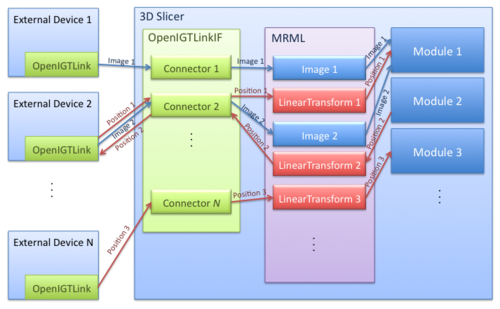Documentation/4.0/Modules/OpenIGTLinkIF
Introduction and Acknowledgements
|
This work is supported by NA-MIC, NCIGT, and the Slicer Community. This work is partially supported by NIH 1R01CA111288-01A1 "Enabling Technologies for MRI-Guided Prostate Interventions" (PI: Clare Tempany), P01-CA67165 "Image Guided Therapy" (PI: Ferenc Joelsz) and AIST Intelligent Surgical Instrument Project (PI: Makoto Hashizume, Site-PI: Nobuhiko Hata). | |||||
|
Module Description
|
The OpenIGTLink Interface Module is a program module for network communication with external software / hardware using OpenIGTLink protocol. The module provides following features:
|
 The figure shows an example schematic diagram where multiple devices are communicating with 3D Slicer through the OpenIGTLink Interface. Each connector is assigned to one of the external devices for TCP/IP connection. The connectors serve as interfaces between the external devices and the MRML scene to convert an OpenIGTLink message to a MRML node or vice versa. |
Use Cases
Most frequently used for these scenarios:
- Quantification of small changes in meningioma tumor volume from post-contrast MRI
Tutorials
Under development
The test data can be downloaded automatically by pushing the "Load test data" in the panel of the first step (you will need the internet connection).
Panels and their use
ChangeTracker is organized as a workflow that consists of the following steps:
- Step 1: Define input scans
| Use drop-down controls to choose the two scans where you would like to measure pathology development. Currently, we support analysis of the images that correspond to two time points. |
- Step 2: Define volume of interest
This step of wizard includes the following user controls to facilitate Volume of Interest (VOI) selection:
"ROI Widget" refers to the three-dimensional selection box that appears in the 3d slice view once you begin to select VOI. You can define VOI by adjusting the colored handles of the ROI widget in the slice viewer or 3d viewer. |
- Step 3: Segment the analyzed structure
| Use threshold control slider to find the intensity that most closely approximates tumor volume. Thresholded volume is rendered interactively in the 3D viewer as you are adjusting the threshold value, and is also visualized as semi-transparent label in the image slice viewers.
Note, that currently ChangeTracker expects that the tissue you monitor is hyperintensive on the image. In the cases when threshold is not effective in segmenting the structure of interest, Advanced tab allows to prescribe the segmentation label image directly, instead of using threshold. (this feature is currently disabled, under development) |
- Step 4: ROI Analysis
Choose the metric(s) you would like to use. ChangeTracker provides an extensible framework for developing and incorporating change quantification metrics into the workflow (see Information for Developers section). The metrics currently available are the following (follow the links for details and documentation):
In some cases, the registration procedure that ChangeTracker is using may not be robust enough to align your data. If this happens and the baseline and followup ROIs are not aligned after this step, you can use the Advanced tab to register your data, and place followup volume under the transform. ChangeTracker will use the prescribed transform and will skip registration step. |
- Step 5: ROI Analysis Results
| Results are reported as the change in tumor volume, separately for growth and shrinkage component. The quantitative results are reported in voxels, mL and percentage relative the the volume of the structure segmented in the baseline scan.
The visualization of the analysis results includes the following components upon the completion of analysis:
|
Similar Modules
- Point to other modules that have similar functionality
References
- Konukoglu, E., Wells, W. M., Novellas, S., Ayache, N., Kikinis, R., Black, P. M., & Pohl, K. M. (2008). Monitoring slowly evolving tumors. 2008 5th IEEE International Symposium on Biomedical Imaging: From Nano to Macro (pp. 812-815). IEEE. doi:10.1109/ISBI.2008.4541120 URL
- Pohl, K. M., Konukoglu, E., Novellas, S., Ayache, N., Fedorov, A., Talos, I.-F., Golby, A., et al. (2011). A new metric for detecting change in slowly evolving brain tumors: validation in meningioma patients. Neurosurgery, 68(1 Suppl Operative), 225-33. doi:10.1227/NEU.0b013e31820783d5 URL
Information for Developers
| Section under construction. |

